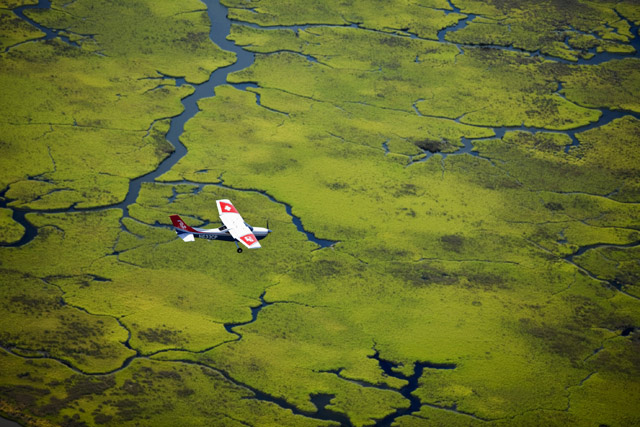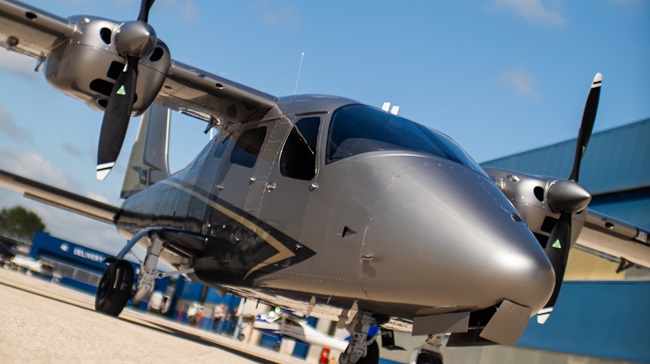Civil Air Patrol pilots add compassion flights

Annie Beaulieu looked at a group of parked airplanes and saw potential. “You could tell they were maintained, but weren’t being flown much. I thought, Does anyone do anything with these airplanes? Then I thought this might be the solution we were looking for.”
Beaulieu was in search of pilots and aircraft for Patient Airlift Services (PALS), to fly patients with noncritical medical needs from across Maine to and from the medical Mecca that is Boston. Beaulieu and her PALS partner, Jim Platz, can log 1,000 hours a year in Platz’s Cessna 414, but there’s even more need. There usually are 200 PALS flights a month from Maine alone.
The seemingly idle airplanes belonged to the U.S. Air Force. They were Cessnas operated by the Civil Air Patrol. Beaulieu told Platz she would simply ask CAP if its pilots and airplanes could be used for compassion flights, such as PALS missions.
CAP Col. Dan Leclair, commander of the Northeast Region and a Maine resident, said he liked the idea and would present it to CAP leadership. “Our organization likes to see 200 hours a year on an airplane,” said Leclair. “Sometimes we have to place an aircraft somewhere for strategic reasons and it’s hard to get proper utilization. Helping our local citizens was my primary motivation.”
He coordinated with PALS and Angel Flight—a similar compassion-flight organization—as well as the CAP national commander, CAP Operations, and the USAF General Council. Requesting a CAP aircraft for compassion flights is now an option for CAP pilots in all 50 states. Pilots sign up for a mission on the PALS or Angel Flight website. Then they submit a request to the CAP National Ops Center, as they would for any CAP flight. When the approval comes back—usually within 24 hours—they’re set.
CAP’s training and currency system are accepted by PALS and Angel Flight in lieu of those organizations’ training requirements. However, pilots still must meet the experience minimums of the medical airlift organization they’re partnering with, which may be more stringent than CAP.
“Most of our pilots like to fly with a purpose. This is another mission that gives pilots a reason to fly,” Leclair said.
www.aopafoundation.org/giving-back
AOPA Foundation
Giving Back grantrecipients
The AOPA Foundation awards Giving Back grants of up to $10,000 to worthy causes that help promote aviation education and safety, help preserve airports, increase the pilot population, and/or facilitate charitable work being done through general aviation. These organizations and their missions will receive grants in 2016:
• Build A Plane. AOPA Foundation grant funds will be used to implement an aircraft-building project designed to be a gang intervention program. Participants will refurbish an Aeronca Champ to airworthiness over a 12-month period. Upon completion of the project, participants will be given flight training in the completed Champ, which qualifies as a Light Sport aircraft.
• Hope Flight Foundation. The Hope Flight Foundation provides lifesaving flights for seriously ill children and AOPA Foundation grant funds will be used to cover upcoming flights in California, Nevada, and Oregon. When costly ambulance rides and commercial air transport are not an option, Hope Flight provides a solution.
• Sophie Gerson Healthy Youth. AOPA Foundation grant funds will fund a weeklong Aviation and Space Camp at the New York City Center for Space Science Education. The camp will be available to more than 30 low-income students from New York middle schools. Students will explore the principles of flight, train on flight simulators, build and fly model airplanes, and take part in simulated space missions.
High School Initiative
Helping STEM students reach new heights
Aviation makes science, technology, engineering, and math (STEM) come alive. A consortium of high school principals, program leaders, school superintendents, and guidance counselors will join AOPA in its High School Aviation Leadership Alliance, which will have its first meeting November 9 in Lakeland, Florida.
If you’re an educator or aviation enthusiast who wants to help introduce aviation to students, plan to attend. This is your opportunity to network with other educators and learn more about aviation education in and out of the classroom.
This one-day symposium will help educators find out how to launch an aviation education program. The symposium will be held Monday, November 9, at the Florida Air Museum on Medulla Road in Lakeland.
“This one-day symposium will help us begin the conversation of how to grow general aviation through the high schools,” said Pat Cwayna, CEO of the West Michigan Aviation Academy and AOPA director of the leadership alliance. “We want to bring the shortage of GA activity to the attention of principals and school leaders. We need to show them how GA can benefit their students and let them know the massive amount of jobs in aviation.”
“There’s no magic bullet that will reverse decades of declining pilot numbers, but we’re committed to welcoming new people into aviation,” said AOPA President Mark Baker. “The AOPA High School Initiative is one more way we’re acting on that commitment.”
If you have questions, contact AOPA via email at [email protected] or visit the website.


